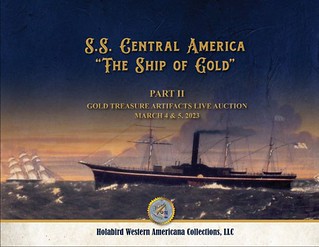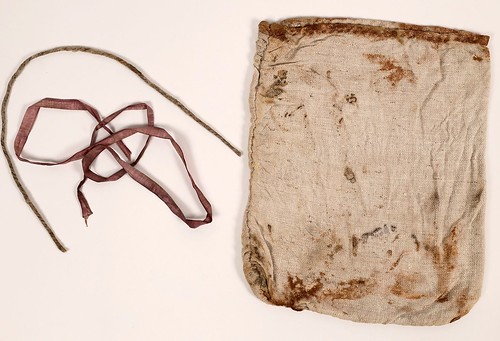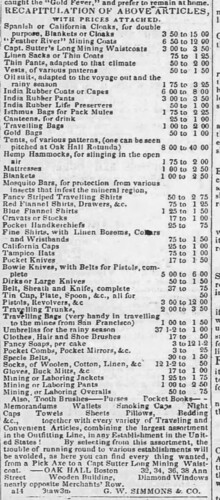
The S.S. Central America second artifacts sale catalog includes a number of great articles. With permission we're republishing
Fred Holabird's piece on "Gold Bags or Pokes Through History". Thank you!
-Editor
 Leather (hide), and cloth bags have been used for gold storage for at least four centuries. Originally hand
made and stitched along edges of deer or other available animal hide, the bags served a very specific
purpose: to hold an article of very great density, particularly gold, in a manner that would not tear open
and spill the contents if dropped. While cloth was an automatic resource, it was not as practical. Thin
cloth splits open easily with weighty contents. Coarse weave cloth (canvas and sail cloth) can lose the
contents of fine gold dust easily, working its way out through the stitch spaces. Likewise, poor stitching
can also cause a quick break in the bag, causing loss of valuable gold contents. For these reasons and
more, animal hide was deemed the best material.
Leather (hide), and cloth bags have been used for gold storage for at least four centuries. Originally hand
made and stitched along edges of deer or other available animal hide, the bags served a very specific
purpose: to hold an article of very great density, particularly gold, in a manner that would not tear open
and spill the contents if dropped. While cloth was an automatic resource, it was not as practical. Thin
cloth splits open easily with weighty contents. Coarse weave cloth (canvas and sail cloth) can lose the
contents of fine gold dust easily, working its way out through the stitch spaces. Likewise, poor stitching
can also cause a quick break in the bag, causing loss of valuable gold contents. For these reasons and
more, animal hide was deemed the best material.
Captain Kidd and his Gold Bags
The gold dust bag goes hand in hand with the history of treasure boxes through history. The earliest
mention located on gold dust in bags comes from America itself and the story of Captain William Kidd.
Kidd was hired in 1696 as a truthful and honest sailing man by private parties in America and England
in cooperation with English authorities to stop piracy at sea and prosecute them. He sailed from England
in April, 1696 for New York. Instead of an immediate voyage across the Atlantic, he sailed around the
Cape of Good Hope, was gone about three years at sea as he got off course and began plundering
ships. It is not known fully if he was plundering pirates, or simply became one himself. Nonetheless, he
returned to New York at Long Island and proceeded to Gardiner's Bay and Gardiner's Island, where he
buried treasure, and left a note with Gardiner himself of the exact location, before leaving to bury other
treasure elsewhere, entrusting Mr. Gardiner with his secret, and making the life of the latter the pledge
of his fidelity. Kidd burned his ship after a time and released his crew. He went to Boston in 1699
thinking no one knew of his plunders, but was wrong, and was immediately arrested by the order of
Governor Bellamont. Bellamont's men soon sought out the various treasures, found Gardiner, and as
soon as assured that Kidd was in confinement, Gardiner then divulged the location of the treasure. The
papers of the Gardiner family show that the contents of the box were bags of gold dust, bags of gold
bars,... ... Kidd was sent to England, tried and condemned.... He was executed May 9, 1701.
Little did Captain Cook know that centuries later his bags of gold dust would make it into one of my
stories.....
One hundred thirty years later, gold stored in gold bags remained the standard. The Georgia Gold Rush
leaves us little to study in regards to gold bags, as the newspapers have not been digitized yet. Gold
bags are mentioned in passing in regional news of the 1837-1838 period, but no specific content was
located.
California Gold Rush
By the time of the California Gold Rush, finding news of gold bags before 1850 is difficult because every
able-bodied man was off to the goldfields, and newspapers were few and far between. Indeed, the Gold
Rush was a mad rush of people from around the world on a first come, first served basis. Supplies were
bought at the departing points, and that is where news of the first gold bags for the California Gold Rush
appear.
One of the first, if not the first, to advertise for California outfits was the Oak Hall store in Boston. His ads
appear in the fall of 1848, offering gold bags and everything imaginable, including rubber life preservers.
Here you can find everything wanted, from a Pick Axe to a Capt. Sutter Long mining Waistcoat. These
advertisements must have been a hit as Oak Hall ran them in newspapers all up the coast to Maine
through 1849. His gold bags were advertised at $0.50 to $1.00 each.
Meanwhile, out in California, one of the first appearances of the use of the gold bag term was in
reference to a steamer from San Francisco to Panama on Dec. 4, 1849, discussing miners with well
filled gold bags, and passengers with a trunk full of the gold of California.
Another very early
reference was in reference to a miner placing a gold bag on a monte table in a gaming establishment
known as the Humboldt in Sacramento in August, 1850.
If enterprising miners did not have their gold
bags bought in the East, or purchased from instant dockside supply businesses, they made their own.
New York merchants soon joined the fracas. Merchant D. Hodgman advertised to California Emigrants
the sale of gold bags and everything else in May, 1850.
California merchants certainly followed soon
after, but much history is lost due to the exodus of working men to the goldfields. By the mid 1850s,
advertisements appeared all throughout the California gold regions for mining supplies, inclusive of gold
bags. In San Francisco, Wm. G. Badger was a prolific advertiser for buckskin gold bags carrying 400 dozen. His ads appeared all over California.
By the time of the SS Central America in 1857, gold bags were available everywhere.
The Gold Bags of the SS Central America
The gold bags of the SS Central America show a wide variety of manufacturing styles, sizes and types.
All of the gold bags were recovered from the purser's safe, though several others were seen in various
forms of degradation, buried beneath sediment and other artifacts preventing the access of oxygen and
thus parts of the original leather remained unconsumed by Mama Nature. These bags generally
contained coins and jewelry. No part of any of them were recoverable, and are simply known by
photographic record on the ocean floor. The leather gold bags varied in size, hide thickness, stitch
patterns and bag ties. There was no standard , but simply what any manufacturer could come up with.
Home made gold bags are also among those preserved. These are identifiable from hand stitching, often
with string or leather instead of fine sewing by early machine. Cloth bags also held gold, but usually, if
not always, held coin. Gold dust would flow through the cloth interstices, rendering cloth bags
inappropriate for gold storage.

Lot 2007 Canvas Coin or Gold Bag
Gold Bags of other Gold Rushes
Gold bags made of hide were also used for other gold rushes from the Australian Gold Rush of the 1850s-1860s to the Pikes Peak Gold Rush of c1859-1860 to the Alaska-Yukon Gold Rush of the c1898-1905 period.
History Adds a New Term to Gold Bag – Gold Poke
Miners today think of gold bags as gold pokes. But where and when did this term originate? A
thorough search of this terminology around the world from the earliest of times for digitized newspapers
that easily goes back to the Appalachian gold rushes of the 1830s to the present time renders a bit of a
surprising result, and also the need to investigate specific word usage through time.
The very first newspaper written reference to a gold poke is from the Alaska Yukon Gold Rush, and is
not found until after 1900. The term appears to be in regular use by late 1901. In mid 1901 the term
appears in relation to gold robbery as well as delivery of gold to the Vancouver assay office.
In 1902 the term began appearing in poetry.
The term poke itself has changed in meaning through time. Many words in the English language
become subject to cultural changes, slang expressions of current or times past, and changes of
symbolism, among other oddities. Poke is one such word. In Webster's 1840 Dictionary of the English Language, one of the meanings for poke is pocket.
In this regard I began a search through my
records and newspaper records of the Georgia gold rush since the timing of both the publication of the
meaning and the gold rush are coincident. This was indeed a great idea. But the newspapers are few
and far between, mostly all on microfilm, particularly the newspapers of the 1830s in Georgia. The word
was not found in relation to gold, but other researchers may dig deeper to seek success.
The word pocket fits the Poke perfectly. Why did it take another 60 years before the term was applied
to a gold bag? We may never know. But now you know that a gold poke is a gold pocket, which makes
complete sense. Today the term is ubiquitous.
To read the complete SSCA II catalog, see:
https://online.pubhtml5.com/esfe/wtez/#p=1
To read the earlier E-Sylum articles, see:
SSCA ARTIFACTS AUCTION PART II CATALOG
(https://www.coinbooks.org/v26/esylum_v26n07a09.html)
COLLECTING AND CATALOGING U.S. MINT BAGS
(https://www.coinbooks.org/v26/esylum_v26n07a30.html)
Wayne Homren, Editor
The Numismatic Bibliomania Society is a non-profit organization
promoting numismatic literature. See our web site at coinbooks.org.
To submit items for publication in The E-Sylum, write to the Editor
at this address: whomren@gmail.com
To subscribe go to: https://my.binhost.com/lists/listinfo/esylum
Copyright © 1998 - 2024 The Numismatic Bibliomania Society (NBS)
All Rights Reserved.
NBS Home Page
Contact the NBS webmaster
| 





